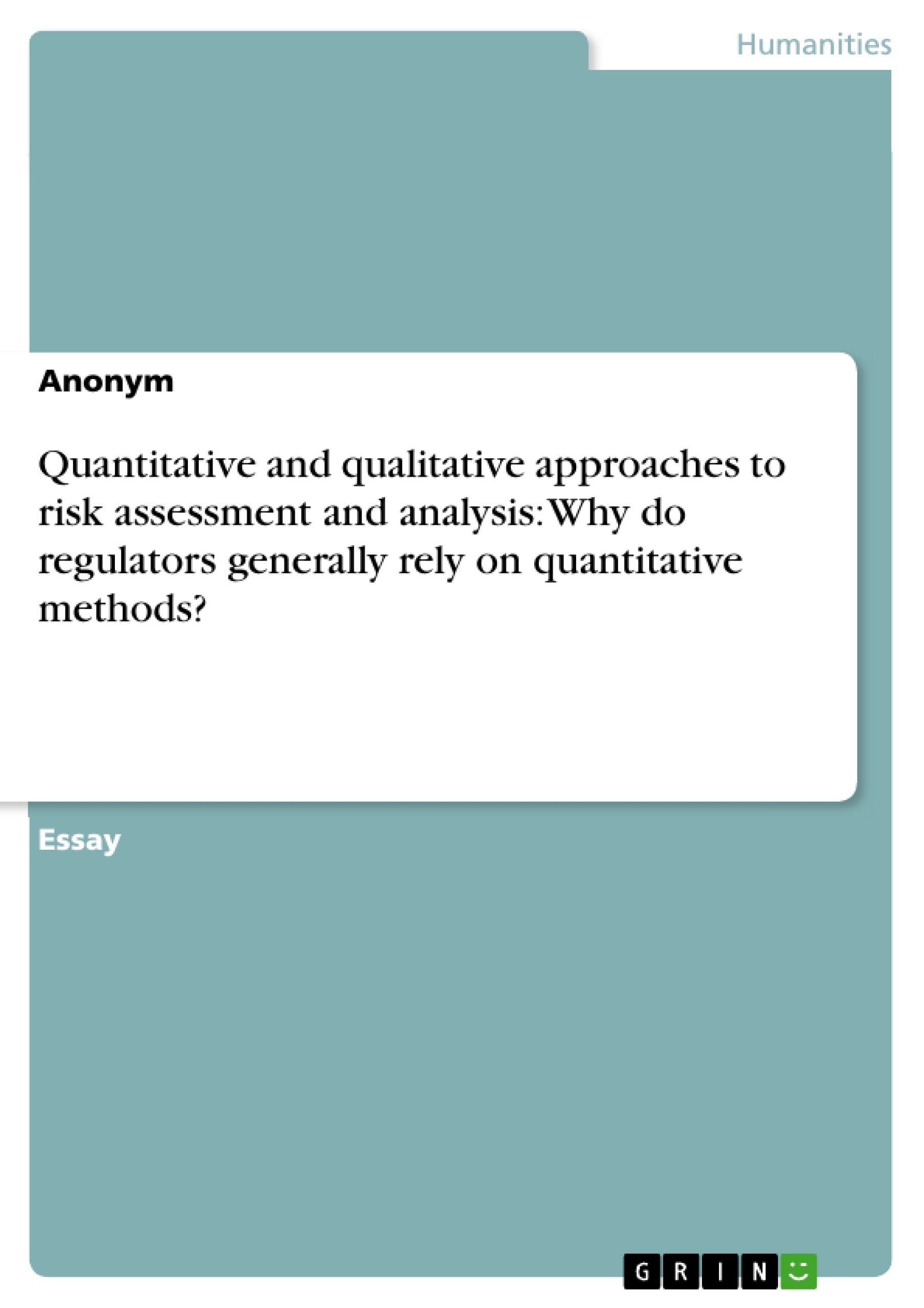The given question argues that there are two approaches to risk assessment and analysis, quantitative and qualitative, and asks why regulators generally rely on quantitative risk assessment and analysis. The essay examines the question by considering first what is meant by the terms risk, risk assessment and analysis, regulators and quantitative/qualitative approach to risk assessment and analysis. With reference to the latter terms, the essay then focuses on the analysis of advantages and disadvantages of both quantitative and qualitative approaches from the regulators’ perspective. By comparison of both approaches the essay then concludes with why regulators generally rely on quantitative methods.
Introduction
The given question argues that there are two approaches to risk assessment and analysis, quantitative and qualitative, and asks why regulators generally rely on quantitative risk assessment and analysis. The essay examines the question by considering first what is meant by the terms risk, risk assessment and analysis, regulators and quantitative/qualitative approach to risk assessment and analysis. With reference to the latter terms, the essay then focuses on the analysis of advantages and disadvantages of both quantitative and qualitative approaches from the regulators’ perspective. By comparison of both approaches the essay then concludes with why regulators generally rely on quantitative methods.
Having outlined the framework of the analysis, the essay will now build on this by considering the terminological issues contained within the question.
Definitions
Before the question can be answered it is important to understand the key terms used in the essay: (i) Risk, (ii) Risk assessment and analysis, (iii) Regulators and, (iv) Quantitative/Qualitative approach to risk assessment and analysis.
Risk
The term ‘risk’ can have different meanings depending on the perspectives of those defining it. For example natural and social sciences may define risk in ways, which reflect their different views. Adams (2001:30), as a representative of natural sciences, states that risk was defined by most who sought to measure it, as the product of probability and utility of some future event. This definition approximately matches with the earlier and more detailed definition of the Royal Society (1983), which defines risk as “the probability that a particular adverse event occurs during a stated period of time, or results from a particular challenge”. Moreover, Moss’s (2002: 22) definition summarizes and defines risk in broad terms, stating that risk exists whenever more than one outcome is possible.
However, issues of natural sciences are not necessarily important to the colloquial use of risk, since what is considered as risky can vary significantly between societies (Douglas et al., 1982: 14). Scientific definitions of risk stand in sharp contrast to the social sciences view, which understands risk as ‘culturally constructed’ rather than ‘objectively measureable’. In this regards the Encyclopedia Britannica (2011) defines culture as “…that complex whole which includes knowledge, belief, art, morals, law, custom, and any other capabilities and habits acquired by man as a member of society”. Therefore in the social sciences’ view almost everything can become perceived as a potential risk depending on the culturally defined criteria of the viewer. Social scientists thereby consent that lay people, by calling something a risk, do not necessarily utilize ‘objectively’ gained knowledge but rather point out an event’s importance to their subjectivity and well-being (Lupton, 1999: 13). In effect they carry out a qualitative risk assessment based upon their cultural criteria and take decisions based on the outcome.
For the purpose of this essay two definitions of risk will be adopted. Firstly, the natural scientific view of Adams, which mirrors the regulator’s point of view that risk is the product of probability and utility of a future event. Secondly, the social sciences view which understands risk as being based on cultural criteria of the viewer. The evaluation of possible outcomes then means that one is conducting risk assessment and analysis.
Risk assessment and analysis
Risk assessment and analysis are both part of the risk management process, which includes activities to avoid and reduce risk (Aven, 2011: 1). Since the process of risk assessment covers also risk analysis, the term risk assessment will be utilized from herein further instead of assessment and analysis.
Risk assessment is viewed as the process of identification of possible hazards, the analysis of causes and consequences and the description of risk (Aven, ibid: 34) with the aim to provide decision support to regulators and lay people alike (Aven, ibid: 38). How risk assessments support decisions of lay people and regulators can be illustrated using bicycle helmets as an example. Lay people’s process of risk assessment whether or not to use a bicycle helmet, may include considerations about possible hazards (e.g. rain), an analysis of the possible causes (e.g. clouds), and based upon the considerations about possible consequences (e.g. slippery roads leading to a higher risk of accidents). This may lead to the decision that wearing a helmet might be a good idea to reduce risk. Regulatory institutions must consider whether or not bicycle helmets should become mandatory for lay people. The process however stays the same. Possible hazards are considered (e.g. traffic), causes are identified (e.g. infrastructure, road conditions), consequences are taken into account (increased risk of traffic accidents involving bicyclists) and afterwards measures are considered, e.g. implementation of regulations. As shown, in both cases the decision-making is supported by a previously conducted risk assessment. However, one might consider in this context why regulators are required, as apparently lay people can take decisions on their own.
[...]
- Arbeit zitieren
- Anonym,, 2011, Quantitative and qualitative approaches to risk assessment and analysis: Why do regulators generally rely on quantitative methods?, München, GRIN Verlag, https://www.grin.com/document/272442
-

-

-

-
Laden Sie Ihre eigenen Arbeiten hoch! Geld verdienen und iPhone X gewinnen. -

-
Laden Sie Ihre eigenen Arbeiten hoch! Geld verdienen und iPhone X gewinnen. -

-
Laden Sie Ihre eigenen Arbeiten hoch! Geld verdienen und iPhone X gewinnen. -

-
Laden Sie Ihre eigenen Arbeiten hoch! Geld verdienen und iPhone X gewinnen. -

-
Laden Sie Ihre eigenen Arbeiten hoch! Geld verdienen und iPhone X gewinnen.

